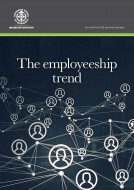
The “employeeship” trend
We are currently seeing a clear trend in the way an organization’s personnel are viewed. The old notion of “obeying and doing what you are told” is changing, and today you are expected to be a “co-leader”. The question is what consequences, benefits and pitfalls are bound up with such a trend.
This is a trendspotting piece from guest writer Kjell Lindström.
The human resources within an organization have been called various things down the ages. During the 1980s transition to the logic of service production, “employee” became “co-worker”. The idea was that the classic conflict between capital and work would be replaced by a consensus that involved everyone pulling in the same direction, embracing the mission and being “aligned”.
Over the past 10 years, a further shift in the focus of personnel appears to have been encouraged. This time it is about drawing new boundaries between the roles of manager and co-worker. With organizations becoming increasingly complex and fluid, co-workers are required to make ever more independent organizational decisions. This has prompted some to talk about the role of “co-leader”.
Of course, it is good for personnel to have a more developed role, but there are certain aspects that are worth considering:
- One problem with the role of manager in many organizations is that it has become increasingly overburdened with administrative and coordinating duties. At the same time, roles such as assistant and secretary have been taken away. There is a risk that instead of solving this problem, you are simply piling the administration onto the co-workers – which then means they have less time to do what they are employed for.
- If co-workers are now going to take on some of the classic managerial tasks (“leading and allocating work”), this will create a certain amount of uncertainty on issues concerning power and authority. It is also likely that wage demands will be higher.
- The question is also why an independent, strategically competent and productive person would give up their independence to become an employee in the first place. Why not remain “self-employed” and hire out your services instead?
- In addition, skilled workers are going to be supplemented with a growing band of self-sufficient robots, cyborgs and other technical innovations.
The future for our co-workers is set to be fascinating. We’re no doubt going to see more flexibility and reciprocity between the roles of leader and co-worker than we do today. One day you’ll be leading a project, the next you’ll be a co-worker on another.
We’ll be following developments with interest.
Download this article:
This article is a trendspotting piece from guest writer Kjell Lindström – author and lecturer on SSE Executive Education’s Executive Leadership Program and Executive Management Program. Kjell has a passion for HR and organizational theory. And for trendspotting.
Kjell Lindström has a background as a lecturer and researcher at Uppsala University. He is editor of the trendspotting newsletter “noden trender” and is the author of books such as “Bortom tankefällan” (2013), “Äkta organisation”(2014) and “Den nakna ledningsgruppen” (2016).
In 2013, Kjell was awarded the Magnus Söderström Prize by Linnaeus University and the Union for Professionals for his contribution to Swedish HR.



